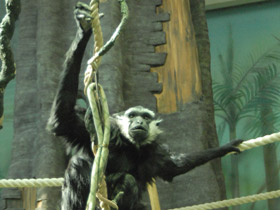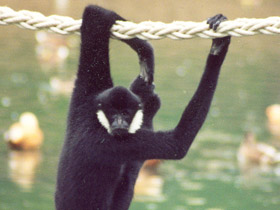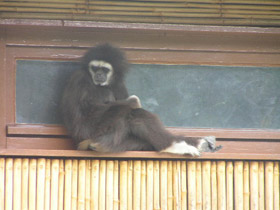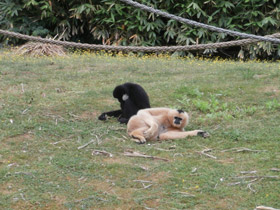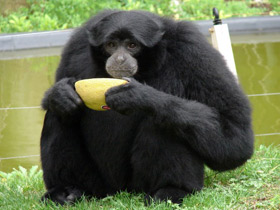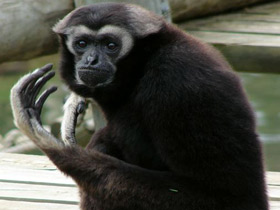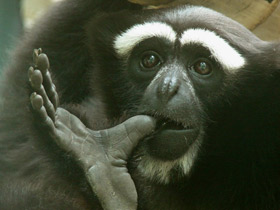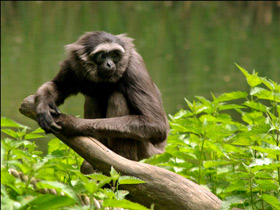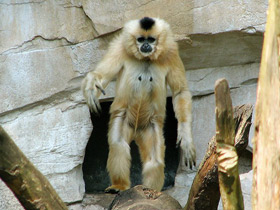The genus Hylobates
The genus Hylobates /ˌhaɪloʊˈbeɪtiːz/ is one of the four genera of gibbons. Its name means "forest walker", from the Greek hūlē (ὕλη, "forest") and bates (βάτης, "one who treads").
It was once considered the only genus, but recently its subgenera (Hoolock [formerly Bunopithecus], Nomascus, and Symphalangus) have been elevated to the genus level. Hylobates remains the most species-rich and widespread of gibbon genera, ranging from southern China (Yunnan) to western and central Java.
Individuals within this genus are characterized by 44 chromosomes and often have a ring of white fur around their faces.
Appearance and distribution
The 9 species of the genus are distributed in Southeast Asia. They are the smallest of the great ape family, with a body length of 45 to 90 cm and a weight of 5 to 8 kg. Hylobates have a very graceful physique, with unusually long forelimbs and thick, soft fur. Their long, narrow, five-fingered hands are very strong and allow them to securely grasp branches of any thickness. Interestingly, female and male Hylobates do not differ greatly in size, but are characterised by sexual dimorphism in colouring: in many species the males are dark, while the females are pale yellow-brown.
Life history
Hylobates live in dense tropical evergreen forests, are arboreal and rarely come down to the ground. These monkeys move through the trees by means of a movement that is unique to them: brachiation (so-called swinging and intercepting with the arms).
In the treetops, these primates move with surprising ease; they literally fly from tree to tree, leaping 10 metres at great speed. On the ground, Hylobates are not so fast, as they amusingly walk on two legs, raising their arms in the air to maintain their balance. Hylobates feed mainly on plant objects (ripe fruits, young leaves), and occasionally eat invertebrates and bird eggs.
Social behaviour
Hylobates live in small groups of 2 to 6 individuals, usually in families with children, and may include 1 or 2 elders. Hylobates are very stable pairs and may persist throughout life. New families are not usually created immediately, but after a long period of courtship from a young male to a female from another group. Pregnancy in Hylobates lasts between 200 and 212 days, and only one young is born. It is almost naked and totally dependent on its mother for at least two years. Hylobates reach sexual maturity at the age of 6-10 years.
Each Hylobate family has its own territory and protects it from other families. At dawn, Hylobates climb to the treetops and start screaming loudly; these "concerts" can last up to 2 hours. These piercing cries, more akin to singing, serve to maintain communication within the pair and to mark territory. After singing, Hylobates often descend and start circling their territory.
Classification
Family Hylobatidae: gibbons:
- Genus Hylobates:
- Lar gibbon or white-handed gibbon, Hylobates lar;
- Malaysian lar gibbon, Hylobates lar lar;
- Carpenter's lar gibbon, Hylobates lar carpenteri;
- Central lar gibbon, Hylobates lar entelloides;
- Sumatran lar gibbon, Hylobates lar vestitus;
- Yunnan lar gibbon, Hylobates lar yunnanensis;
- Bornean white-bearded gibbon, Hylobates albibarbis;
- Agile gibbon or black-handed gibbon, Hylobates agilis;
- Western grey gibbon or Abbott's grey gibbon, Hylobates abbotti;
- Eastern grey gibbon or northern grey gibbon, Hylobates funereus;
- Müller's gibbon or southern grey gibbon, Hylobates muelleri;
- Silvery gibbon, Hylobates moloch;
- Western silvery gibbon or western Javan gibbon, Hylobates moloch moloch;
- Eastern silvery gibbon or central Javan gibbon, Hylobates moloch pongoalsoni;
- Pileated gibbon or capped gibbon, Hylobates pileatus;
- Kloss's gibbon or Mentawai gibbon, bilou or dwarf siamang, Hylobates klossii;
- Genus Hoolock;
- Genus Symphalangus;
- Genus Nomascus.
Hybrids
Hybrids between Müller's gibbon (Hybrids muelleri) and the Bornean white-bearded gibbon, (Hybrids albibarbis) have been reported in areas of Borneo. A gibbon born at the Kujukushima Zoo in Japan to a female lar or white-handed gibbon (Hybrids lar) was determined to have been fathered by a male agile gibbon (Hybrids agilis).

















